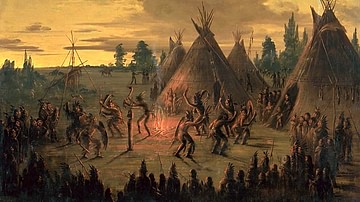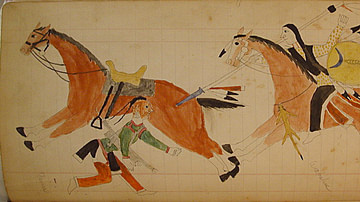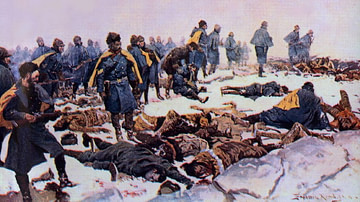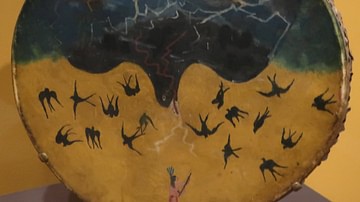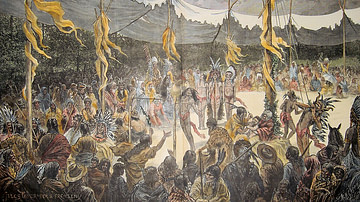The Cheyenne afterlife is envisioned as a continuation of life on earth. The spirit leaves the body and travels the long road of the Milky Way to arrive at a village very like what one has always known and is greeted by those who have gone before. The spirit then lives on with one's Creator and community.
The Creator, Heammawihio or Maheo (Ma'heo'o) – the Wise One Above – welcomes all the spirits equally except those of people who died by suicide, as an outcast of the community, or lived a narrow life of selfishness. When these people die, their spirits direct themselves to the short road along the Milky Way that leads to darkness and, lost there, may sometimes return to earth – to the community they knew – as a ghost to frighten, torment, or trick the living into making the same mistakes they did in life and so meet the same fate in the afterlife. This is one of the many reasons the Cheyenne, like other Native peoples of North America, tell stories warning people of the dangers of interacting with, or entertaining, ghosts.
For most people, however, the long road of the Milky Way is clear, and they arrive safely in the community of the afterlife, welcomed by their Creator, to live eternally, hunting, fishing, and doing whatever they had always done on earth. Visions of this afterlife were reported by those who were sick or badly injured, and then recovered, as well as by those who engaged in the religious movement known as the Ghost Dance, in 1889-1890, especially.
The specifics of the Cheyenne afterlife were recorded in detail by the anthropologist and historian George Bird Grinnell (l. 1849-1938) who lived among them and who also had at hand the invaluable resources of the Cheyenne-Anglo interpreter and historian George Bent (also known as Ho-my-ike, l. c. 1843-1918) and the scholar and researcher George E. Hyde (l. 1882-1968), ensuring accuracy. Grinnell's books on the Cheyenne, Pawnee, and other Plains Indians are still regarded as some of the most important written on the subject.
The Soul & Afterlife
The Cheyenne Creation Story presents their view of the world as an extension of the Creator and, as Maheo is all-good, so is the creation. There is no "evil" in the world, and so there are no evil people; only people who mistake what is good. All living things are understood as equally precious and deserving of respect since all carry a spark of the divine, whether a human, a rock, tree, dog, or buffalo. Humans and animals, however, possess a spirit known as the tasoom – an immortal soul – which inanimate objects do not. When one dies, one's tasoom returns to the One who created it, and so the Cheyenne afterlife is populated not only by the spirits of people who have died but of horses, dogs, buffalo, and any other animal. The landscape of the afterlife – the rocks and trees and prairie – reflects what people knew in life as unchanging and eternal, possessing a divine spirit but not a tasoom.
At birth, the tasoom is a blank slate and takes on its characteristics through the choices one makes in life. A person who has respected the traditions of the community and one's family, who has recognized that the good of the many outweighs their own individual desires, expands their soul and, even if they have failed in various aspects of a virtuous life, can still expect to be welcomed home in the afterlife. The Cheyenne tale The Life and Death of Sweet Medicine about the great lawgiver and prophet Sweet Medicine, highlights the value of placing the greater good above one's own. Those who turned their backs on their community and family, however, or who chose to place their own desires above the plan set for them by Maheo, find their spirits lost in the afterlife; not because they are not loved by Maheo, but because their choices in life crafted their tasoom in such a way that it cannot find the open road toward home.
In the passage below, Grinnell notes how, "all who have died are equal. After death, there is neither reward for virtue nor punishment for sin" (91), which is true. Maheo turns no one away from their homecoming; the tasoom itself turns away from Maheo because of the color and shape it took on while it inhabited a body and was satisfied in living only for itself without thought for others, including the Creator or generations not yet born.
The afterlife was understood by the Plains Indians as an absolute reality – as it is by their descendants living today – and it was understood that one would live there in the same form, however ethereal, as the body one had left behind on earth. It is for this reason that the Cheyenne, the Sioux, the Pawnee, Cherokee, and others would mutilate the corpses of fallen enemies. The soul of that person would then go on to the afterlife where they would be missing hands, feet, eyes, or other parts and so would not be able to enjoy their eternal life. The reality of the afterlife is also what energized the Ghost Dance movement of 1889-1890 (though, for some nations, like the Pawnee, it continued to be practiced into the 20th century): participants in the round dance would fall into trances in which they would see the villages, prairies, buffalo, and the spirits of the departed clearly and would then tell others of their vision, encouraging more people to join the movement.
Text
George Bird Grinnell could not speak the Cheyenne language and so relied on the skills of the famous Cheyenne-Anglo interpreter George Bent. Bent, a Cheyenne warrior educated in Euro-American schools, is responsible for some of the most famous works by Anglo writers on the Plains Indians, including those of James Mooney (l. 1861-1921). He also worked closely with the scholar and researcher George E. Hyde who proofread Grinnell's manuscripts and claimed to have ghostwritten his The Fighting Cheyennes (1915).
George Bent was a brilliant bilingual historian and George E. Hyde was a meticulous researcher, historian, and writer, and, as they were largely responsible for the contents of Grinnell's work, it is considered accurate, and Grinnell's claims are supported by the works of other reputable historians and scholars. His passage on the afterlife below, like many in his works, was derived from interviews arranged for him by Bent with Cheyenne medicine men and others and so it reads, for the most part, as though one is hearing the account as it was told to the original Native American audience.
The following passage comes from George Bird Grinnell's The Cheyenne Indians: War, Ceremonies, and Religion, Volume II (1923), republished in 1972 by University of Nebraska Press, pp. 90-94:
When Heammawihio [Maheo] first made people, he made them to live. When they died, they were to be dead for only four nights, and then they would live again. After a little time, the Creator found that this would not do. It would have made people too brave, and they would have done too much killing. That is why now people die forever. If it had continued as at first, people would have been like the bald eagle. You may go out and kill a bald eagle, and take him home and use his feathers, and in four days, if you go back to the place where you killed him, you will again find the bald eagle on or near its nest.
At one time, Heammawihio was with the people on the earth. He it was who taught them how to make stone arrowpoints, and knives of stone and bone for cutting. He instructed them how to take the arrowpoints he had taught them to make, and to put them on shafts, showed them how to make a bow, and how to use the arrows for shooting. He told them that the animals, the buffalo, the elk and the deer – all the animals that are on the earth – and the birds of different kinds, were for them to kill and subsist on. They made their fire, as he had taught them, with two sticks rubbed together till the fire started, and also by knocking together two hard stones.
In those days, Heammawihio told them that there existed many other peoples that they had never seen and that, after a time, they would meet them; they would find all these people armed as they were, with stone arrows, and stone and bone knives; he had taught all the people on the land the same way to live.
Heammawihio showed them the corn, and told them to plant, and cultivate, and eat it, saying that, after a long time, all people would learn to plant and raise grain, and to grow other things for their subsistence. On the other side of the big water, he said, a different people were living, and a day would come when these people would cross over to this side of that water, and they would see them. A time would come when there would be wars, and many people would be killed.
After Heammawihio had been long with them, and had taught them how to live, he told them that he was going up to the sky, that he would watch over them, and that when they died, they should come to him; while they were on earth, they might have much trouble, but when they died all would go up into the sky and live with him.
Seyan [Sehan], the place of the dead, is above, where Heammawihio lives. Those who die are with him, excepting only those who have killed themselves. Brave and cowardly, good and bad alike, go there. All who have died are equal. After death, there is neither reward for virtue nor punishment for sin. The spirit of the one who has died goes up above to Heammawihio. Seyan is reached by following the Hanging Road, the Milky Way. There the dead live as they lived on earth – they chase buffalo, hunt other game, and go to war. Occasionally, people who have been very sick believe that they have died and gone to this country, and then have returned again, but they seem never actually to reach these camps of the dead. They perhaps come within a short distance of the village, and may meet and talk with people coming from and going to it, but they never quite reach it. Before doing so, they return to life. They describe the camps, and tell of the white lodges handsomely painted, the people passing to and fro, the scaffolds hung with drying meat, the women tanning robes, all the sights and sounds of a camp, just as they know it here.
Picking-Bones-Woman – sister of Red Eagle, a Northern Cheyenne doctor – when eighty-four years of age (born about 1818) told me of her experience about fifty-four years earlier (1848) when she had died and gone to the place of the dead.
Not very long after she had been married, she was very ill…One morning, just after the sun had risen, she was sitting, bent over, when someone called to her: "Picking Bones, they want you over there! Your mother wants you!" Her mother had been long dead.
She arose and left the lodge and went straight north. She did not walk on the ground; she was running, but her feet did not touch the ground – they seemed to move a little way above it. She looked neither to the right nor left, but straight before her. She felt as if she were flying. As she looked down, the grass appeared yellowish red before her. All at once, she came to the top of a hill and, looking at the ground before her, it seemed green. Then, just in front of her, she saw a big bluff, and in it a door. She ran right up against the door and, when she struck it, it opened, and she fell through the door on her left side. She felt the unevenness of the ground against her body as she lay there.
Someone spoke to her, and said, "Your mother has gone back." She did not see the face of the person who spoke, but she saw his legs from the knees down; he wore blue striped leggings. As she rose to her feet, she saw old men sitting all about her. They had their hair dressed in different ways, according to the old-time fashion, some of them having it tied up in great bunches on the forehead. The bodies of all were naked but all wore buffalo robes about their waists and legs. One man who sat nearest to her she recognized; it was Red Water, who had been dead a long time. The person who had spoken to her, spoke again, saying, "You must take this baby back with you; it is your husband's child." She stretched out her arms and he put into them the naked child, which she held.
She then went out the door and came back to her lodge just as she had gone from it but carrying the baby before her. While she was going back, she did not touch the ground, but went just as if she were flying. She remembers reaching her home and going in, holding the baby. Her husband was sitting there, and she said to him, "Here is your child; take it." She handed it to him. Then she turned and looked at her bed and saw there her body lying on the bed. She does not know how her spirit went back to the body but, when she came to herself, she was sitting up. She rose to her feet and, when she did so, she felt well. Her body had not been gone from the lodge. No baby had been in the lodge.
[A person's] spirit, or living principle is called their shade or shadow, tasoom; that is, the soul, mind, or spiritual part; not the body, the immortal part. Tasoom is also the shadow of any animate thing, as a man, horse, bird, or dog. It is not the shadow of a tree, a rock, or a building. Of a dying person who has lost consciousness and merely breathes, they may say, "His tasoom has been gone a long time; he is only just breathing."
Those who die become shadows or spirits. If a man sees his shade, it is a sign that he will soon die. A sick man may send for a friend to come to him and say, "Well, my friend, I have sent for you that I may see you once more, for I am about to die. I have seen my shadow."
Women saw their shadows more often than men and, with them, the vision was not certainly followed by death. If an old woman had been badly frightened, she might say, "I was so badly frightened that I saw my shadow." The idea seems to be that her life was literally frightened out of her body and, for a moment, stood before her. The shadow is a mere shape, seen for an instant, and then gone. It is like a shadow in having no detail; no clothing, no features – a silhouette.
Years ago, Indians commonly refused to be photographed, because they believed that, when the picture was taken away, the life of the subject was taken away too, and the actual man would die. They regarded the photographic print as the man's shadow. In the same way, in early days when little trade mirrors were first received, many people refused to look into them, because they would see their shadows, and bad luck would follow.




